Being proficient with your gear, posing, lighting and people skills are all very important skills of somebody that wants to be a wedding photographer. However, part of being good with people is being good with groups. Time is one of the most valuable assets while shooting a wedding. If people aren’t doing what you ask of them, you are going to find yourself quickly running out of time for the photos your clients are going to expect to see. Here are the tools you’ll need to manage people in almost any setting.
Create a game plan
This starts from the very first time you meet with a new client. You should begin to understand what kind of wedding they are planning by listening to their thoughts and ideas. Are they going to want mostly combination’s of different family, friends or other groups?
Do they want a more documentary style coverage, and not be so concerned with every family combination? All of this will enable you to create an outline that will paint the best picture of the day you can. You’ll be able to share this with your second shooter, so that they are on the same page.
Say hello
Usually the only people you have met prior to a wedding is the bride and groom. So you really need to make it a point to try and find all of the “VIP’s” when you arrive to the wedding and introduce yourself. This includes parents, bridesmaids, groomsmen, personal attendants etc … all you have to do is give them a quick hello and, “My name is …”
This sets them a little more at ease. I think most people have heard or witnessed horror stories with some wedding photographers, so they sometimes expect the photographer to be someone they will probably not get along with. This is where you can begin to build a relationship by letting everyone involved with the wedding see that your a fun person!
Voice your expectations
Let the wedding party know the game plan. Like how much time we have, where we are going and a quick description of your style. Personally, mine is fun and relaxed. The posing isn’t rigid and your not standing in the same spot holding the same smile and pose for minutes on end. One way to avoid that, is making sure you get your exposure and composition correct quickly. Once you get a wedding party into the pose you want, they will quickly start to fall out of place. So while your posing them, maybe have your second shooter confirm what settings you might want as a starting point.
Have a plan and execute it
Come up with a set of shots that make sense to transition from one to another without completely starting from scratch. Meaning, don’t go from posing the entire wedding party to posing just the bride and groom and then back to the wedding party. You’ll be wasting too much time. Start with the wedding party as a whole.
It always seems like their attention span might fall off quicker then the bride and groom’s. Here is an example of a two group shots that work really well for quickly transitioning from one to the other.
This shot …
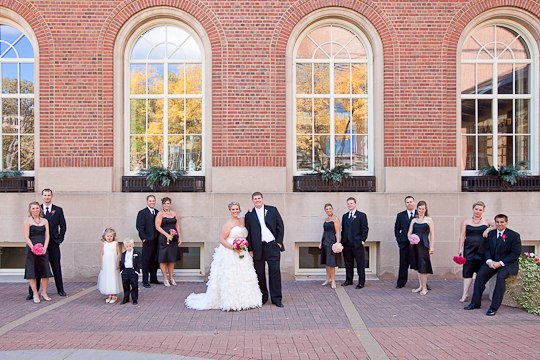
Can quickly become …
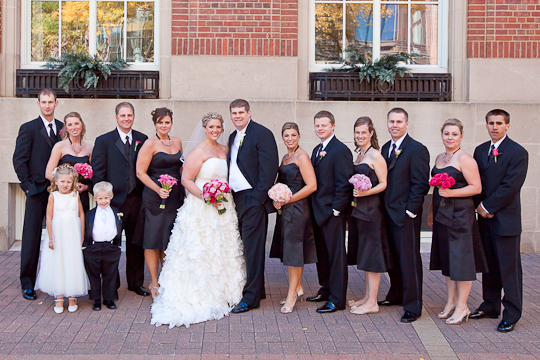
By keeping everyone paired up with who they will be walking down the aisle with, you can move them easier from location to location as well.
As in this shot …
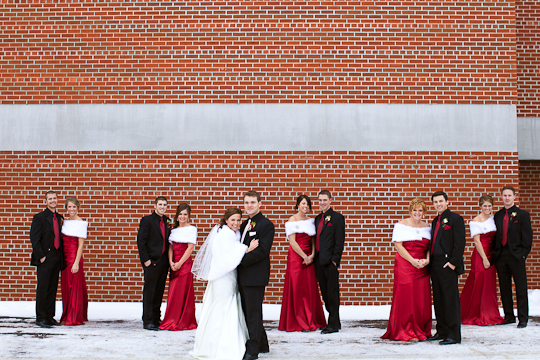
Which easily becomes …
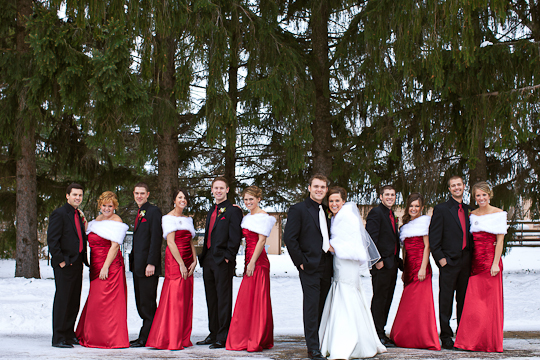
All Photos © Chris Emeott
Something that has also really worked well for me is to try and call everyone by their first name.
This will get their attention faster and seem much more personable that just pointing and saying “You go that way. You step forward.”
It also will make you more memorable as a photographer because not everyone does this.
Interacting with the group
While working with your group, it really helps if you keep everything light hearted and stress free. The group is looking to you for advice on how to look their best. You may have shot 100’s of weddings and knowing where the bridesmaids should hold their flowers or what the groomsmen should do with their hands is second nature to you.
But chances are, they have no clue.
Most of the pro SLR cameras are fairly large. Add a battery grip and flash and its pretty easy for your head and face to get lost behind the camera.
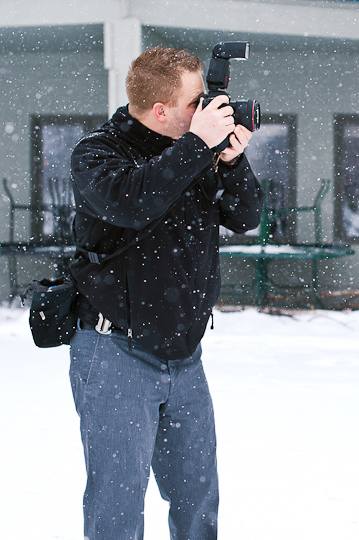
Photo © Karin Newstrom
This is why its very important to continue to be verbal while you’re shooting. The group can’t see what they are doing as a whole, so you need to keep talking and either tell them who needs to move where or other small tweaks. Once you get them where you want, continue to let them know they look great.
Rotate
Make sure you rotate who you are taking pictures of throughout your allotted time. People are going to need breaks, and that includes the bride & groom. If you keep anyone in front of the camera too long, your going to see the smiles become a bit more forced and people might start be less willing to cooperate.
These are perfect times to break the group up into bridesmaids only or groomsmen only. If you have a second shooter, you can save time by dividing up and capturing each group on your own.
Manage the static
Throughout the day you are going to hear input from just about everyone involved with the wedding. One of the most important thing to remember, is that you are working for the bride and groom. Uncle Bob might have suggestions on how you should place the bouquets on top of the brides train then convert it to black & white in photoshop, except for the flowers of course.
Just use your common sense here. Come up with something like, “If we have time, that would be a great idea.” Or if people are persistent, you can politely explain to them that the bride and groom have a different vision of what they want their photos to be.
Paparazzi
This usually won’t happen as much until you get into the church where the majority of the family and close friends are. As soon as you pose up a group, you can always hear the “ooohs” and “aaahs” behind you. You can almost bet that when you turn around your going to see 5 people standing on your heels trying to shoot over your shoulder. Some photographers don’t let people shoot their poses, so that they can sell more prints of that shot. I don’t let people shoot while I’m shooting mostly so I know that everyone is looking at my camera. Time permitting, I will step out of the way and let the paparazzi snap shots for a few seconds. You have to be pretty quick to cut them off otherwise its going to get out of control. Multiply that by 10-20 formal set ups and you are really starting to wasted time if you let it go too long.
Thank everyone
We get the majority of our bookings from referrals and word of mouth, so at the end of each wedding, I just try to thank the close family and the wedding party. I’m not saying to wiggle your way out onto the dance floor during the chicken dance just to say goodbye to a bridesmaid or groomsmen, but when you know that your night is coming to a close soon, make sure to thank them for cooperating and helping make everything run so smoothly.
Trust me, it works.
Final Thoughts
For anyone that has shot a wedding, you know as well as I do that time is almost always working against you. Getting a good plan “A” and plan “B” with your clients prior to their wedding will give you a much better chance of having everything go smoothly. Make a plan 3 months out from the wedding so the bride and groom can notify the other vendors what the plan is. Things will change, so you’ll double check and verify the plan a week prior to the wedding.
Do you do this? Create a worksheet, then email it to the bride before you actually call or meet. This way she can prepare.
Never assume that people are going to know where to be and when to be there. Shooting weddings may be something you do 25 times a year but for the wedding party, it may be their first. They will be looking to you for direction.
So, do you get nervous when the wedding party is 8+ people on each side? What are some of the tricks you use to get people moving in a timely fashion? I’d love to hear your thoughts!
Let us know over on the XEQUALS Facebook page.
Happy shooting!
Save


